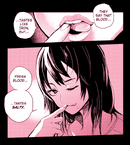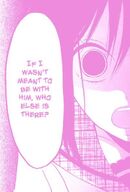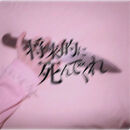Reason for Warning: This page discusses mental health, as well as occasionally having violence, blood, and gore and mentions of unhealthy and obsessive behaviors, such as stalking, gaslighting, and many more.
Yandere (ヤンデレ), derived from the Japanese words "yanderu" (to be mentally ill) and "deredere" (lovey-dovey), describes a character archetype with an unhealthy love-related obsession that often results in violent outbreaks triggered by unrequited love or disappointment. Another similar type of character would be Yangire, who turns violent regardless of love.
Controversy[]
Due to the controversial nature of Yandere as a trope in anime, often criticized of fetishizing or demonizing the mentally ill as well as romanticizing abuse, this aesthetic had to become distinct from the more wholesome Lovecore on a level beyond their aesthetic differences. Some mentally ill people choose to indulge in Yandere to find like-minded others and reclaim the concept as a form of (albeit somewhat unhealthy) coping mechanism.
Overview[]
In general, Yandere is a character that is often depicted in a state of paraphilia (sexual perversion), manic depression or co-dependence. The term is generally only used in reference to fiction, and does not hold any actual background in psychatric diagnosis. The "crazy" state of a Yandere is also referred to as "darkening" (闇化) and "blackening" (黒化) in Japanese due to the shadow cast on the face of the character. Fans like the extra ordinary degree of affection that a Yandere shows towards their darling.
However, the definition of Yandere is fluid and often has different meanings depending on the context. For example, on the Japanese website New Akiba, it is described as "a moe-type heroine that is suffering from a wicked heart", and in "Keitai Watch" it's described as "a character who seems to be mentally ill". It is sometimes pointed out that some of the attributes of a Yandere character are reminiscent of borderline personality disorder.
History[]
It is assumed that the term "Yandere" first started to spread among the mainstream media in 2005 because of the release of the visual novel "School Days" and the TV broadcast of the anime "Shuffle!". Shortly after that, Yandere has become a popular character archetype in various media. However, even before the term was coined, there were already multiple characters whose attributes would fit under Yandere. According to the Japanese website "Yandere Encyclopedia", the first instance of a Yandere character would be the 10 years old "loli"/underaged girl character Minatsu Tsukishima of the adult visual novel "Kurutta Kajitsu" from 1992. In order to monopolize the MC (main character), who is also her teacher, she starts killing all the women in his life one after another in gruesome ways in an attempt to make him commit suicide just so she can stay with his corpse forever. The use of the term "Yandere" then was popularized by NekoNeko Soft who used it describe the side character Sasai Yuuna, who appears in Chapter 3 of their visual novel "Gin'iro" from 2000.
Mathers Numakichi, the representative of the company Overflow which produced School Days, describes the Yandere boom as "a manifestation of wanting to seek more steadfastness and favor towards oneself". When asked regarding one of the heroines, Kotonoha Katsura, being labeled as Yandere, he answered, "I wasn't aiming for a Yandere character, so it was more of a lucky coincidence rather than something I 'created' on purpose". He also pointed out that the visual elements of the character were kind of mixed, and stated that "Both tsundere and yandere were a reflection of that time, people wanted to bring a person's inside to the outside".
In the late 2000s, the term "Yandere" also spread among the overseas anime community, and even western games started to incorporate this character archetype. However, the mainstream perception of the term in Japan is still mostly in a negative context, also fueled by multiple instances of murder cases by self-proclaimed "Yandere", such as Yuka Takaoka, who have been celebrated by fans of the genre.
Visuals[]
Common motifs are anime and manga screencap edits of Yandere characters, such as Yuno Gasai, pastel text message edits, knives, blood, gore and fetish gear. There is an overlap with the Japanese art movement, ero guro, often shortened to just "guro", which is associated with the Gurokawa aesthetic.
Media[]
Characters[]
- Yuno Gasai (Mirai Nikki)
- Satō Matsuzaka (Happy Sugar Life)
- Yukako Yamagishi (JoJo's Bizarre Adventure: Diamond Is Unbreakable)
- Griffith (Berserk)
- Kaede Fuyou (SHUFFLE!)
- Mizuki Himeji (Baka to Test to Shoukanjuu)
- Ryouko Asakura (Haruhi Suzumiya na juujutsu)
- Shiro (Deadman Wonderland)
- Sonozaki Shion (Higurashi no Naku Koro ni)
- Lucy (Elfen Lied)
- Megumi Shimizu (Shiki)
- Anna Nishikinomiya (Shimoneta)
- Shuu Tsukiyama (Tokyo Ghoul)
- Akane Hiyama (Love Tyrant)
- Misa Amane (Death Note)
- Kotonoha Katsura (School Days)
- Rolo Lamperouge (Code Geass)
- Ayano Aishi (Yandere Simulator)
- Ryoba Aishi (Yandere Simulator)
- Monika (Doki Doki Literature Club!)
- Yuri (Doki Doki Literature Club!)
- Himiko Toga (Boku no Hero Academia)
- Peter (Your Boyfriend)
- Miyuki Sone (Kimi to Kanojo to Kanojo no Koi)
- Saiko-Chan (Saiko No Sutoka)
- John Doe (John Doe)
- Sae Maki (Sae-ism)
- Hisoka Morow (Hunter x Hunter)
- Grell Sutcliff (Black Butler)
- Genocide Jack (Danganronpa: Trigger Happy Havoc)
- Kanade Otonokoji (SDRA2)
Manga & Anime[]
- Abnormal-Kei Joshi
- Alice in Murderland
- Ana Satsujin
- Cock Robin Wo Korosu No Wa
- Dead Tube
- Durarara
- Happy Sugar Life
- Hiai Mousou
- Ibitsu
- Ijousha no Ai
- Kimi ni Aisarete Itakatta
- Killer in Love
- Konya wa Tsuki ga Kirei desu ga, Toriaezu Shine
- Mirai Nikki
- Sae-ism
- School Days
- Shimoneta
- SHUFFLE!
- Uwakoi
Video Games[]
- Yandere Simulator (2014)
- Doki Doki Literature Club! (2017)
- Yandere School (2017)
- John Doe (2021)
Music[]
Songs[]
- Pretty Little Psycho (Nightcore) by Porcelain Black
- Love Taste by Moe Shop, Jamie Paige & Shiki
- Yandere by Jazmin Bean
- Suki Suki Daisuki by Jun Togawa
- Scissorloid by Zawazawa-P, Hatsune Miku & Megurine Luka
- Love Love Nightmare by kiichi & Hatsune Miku
- Notice Me Senpai by iHasCupquake
- The Zombie Song by Stephanie Mabey
- Yandere Complex by Sewerslvt
- I'm so crazy for youuu ᐸ/3 by Rebzyyx
- An Unhealthy Obsession by The Blake Robinson Synthetic Orchestra & Gloom Darkheart
- I Can't Decide by Scissor Sisters
- Smoke and Mirrors by Jayn
Resources[]
External links to help get a better understanding of this aesthetic.
Communities[]
Playlists[]
- Jazmin Bean playlist (yandere-ish music) on YouTube[1]
- Anime yandere girl playlist - Yanderecore
- YandereCore 🔪❤️ Spotify playlist by Masked Angel
- YandereCore Spotify playlist by moonlitdustball
- ⚠️YANDERECORE⚠️ Spotify playlist by NagitoKomaeda
- YANDERECORE (BrAiNfUcK V2) Spotify playlist by VORPAL2K
- Yanderecore Spotify playlist by kristinenb98
- D̶̼̾̆͝ę̴͔͕͎̫̩̐ͅͅạ̴̖͈͚͎̭̳͉̝̺̊̂d̶̛͔̺̻̼͆̐̈́̒͑ ̷̨̧̘̙̰̼̬̏̒̈̎̓ͅX̷̧̡̛̞̯̣͓͍͇̻̐̀̓͊̿D̷̨̡̺̭̻͉̄ Spotify playlist by nugget_030
- Yandere by Jazmin Bean on YouTube
























